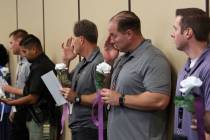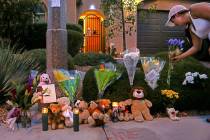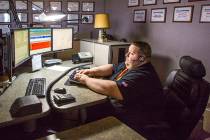Want to see where crime is in Las Vegas? These resources can help
A version of this story originally was posted on March 17, 2017.
While driving around the valley with friends, I’ll often point out former crime scenes — places I’ve stood while waiting to talk with police and sidewalks I’ve roamed while reaching out to neighbors or witnesses.
One friend called me a walking, talking crime map.
Maybe that’s why, every once in awhile, readers ask me for advice on where to live. Henderson? North Las Vegas? Summerlin?
I’d never recommend one place or write off another. But here are a few resources I often recommend to help readers make their own decisions.
Maps
One of the most useful resources is an actual crime map available via the Metropolitan Police Department’s website. The map, developed by TriTech Software Systems, allows you to input a specific address and then view recently reported crimes.
The map is helpful because it gives you a peek at even minor nearby crimes, which the Las Vegas Review-Journal doesn’t typically cover. Even if you’re not moving, it’s good to be aware of your surroundings.
Another handy map tool available to everyone in the valley is on the Nevada Sex Offender Registry website. Its geographical search allows you to enter your current or future address and view registered sex offenders in your area.
Community meetings
If you have time in between moves, or if you’re curious about your current community, Metro also hosts public meetings on the first Tuesday of each month in substations, or “area commands,” around town, which Metro spokesman Michael Rodriguez called an “invaluable tool.”
“You can actually sit there and talk one-on-one with an officer who works in that area,” Rodriguez said.
Everyone is welcome, and they typically start at 7 p.m.
Police-certified apartments
Rodriguez also mentioned a certification program between police and property owners that aims to reduce crime and police calls at certain apartment complexes.
“Crime prevention specialists go and actually inspect the properties, making sure pathways are well lit, bushes are trimmed,” Rodriguez said. They also make security recommendations to management.
Once the property is up to standards, the complex is certified. The voluntary program is called Crime Free Multi-Housing and includes more than 50 certified properties.
“We also tell people: Visit these places. Go during different times of day. Talk to the management,” he said.
Avoiding scams
Once you’ve moved, you may wish to buy items for your new home. Rodriguez said it’s perfectly legal to conduct private transactions, such as those initiated on Craigslist, at police properties throughout the valley.
“We have people who come here to headquarters during business hours (for sales and purchases),” he said. “It’s a public area.”
It’s also a crime deterrent, he said. In a recent case, a woman allowed a Craigslist customer to come to her place of work, and the customer paid her in counterfeit bills. Maybe criminals won’t feel as bold in a police parking lot.
This column originally ran on March 18, 2017. The column, Vegas Vice, previously appeared every other Saturday. You can still contact investigative reporter Rachel Crosby at rcrosby@reviewjournal.com or 702-477-3801. Follow @rachelacrosby on Twitter.
RESOURCES:
Nevada Sex Offender Registry map
Crime Free Multi-Housing Program























